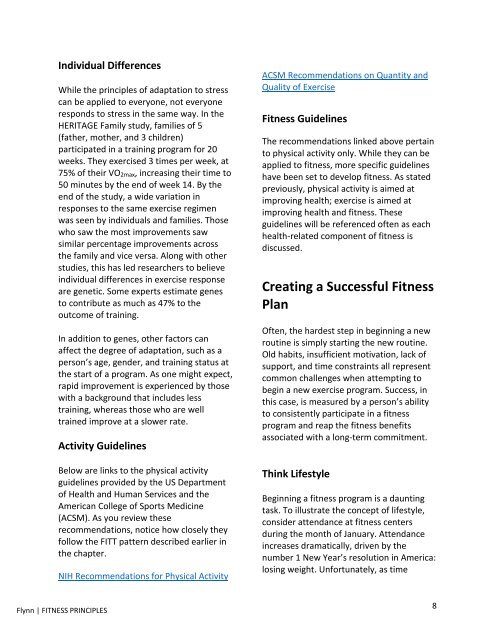Concepts of Fitness and Wellness 2e, 2018
Concepts of Fitness and Wellness 2e, 2018
Concepts of Fitness and Wellness 2e, 2018
You also want an ePaper? Increase the reach of your titles
YUMPU automatically turns print PDFs into web optimized ePapers that Google loves.
Individual Differences<br />
While the principles <strong>of</strong> adaptation to stress<br />
can be applied to everyone, not everyone<br />
responds to stress in the same way. In the<br />
HERITAGE Family study, families <strong>of</strong> 5<br />
(father, mother, <strong>and</strong> 3 children)<br />
participated in a training program for 20<br />
weeks. They exercised 3 times per week, at<br />
75% <strong>of</strong> their VO2max, increasing their time to<br />
50 minutes by the end <strong>of</strong> week 14. By the<br />
end <strong>of</strong> the study, a wide variation in<br />
responses to the same exercise regimen<br />
was seen by individuals <strong>and</strong> families. Those<br />
who saw the most improvements saw<br />
similar percentage improvements across<br />
the family <strong>and</strong> vice versa. Along with other<br />
studies, this has led researchers to believe<br />
individual differences in exercise response<br />
are genetic. Some experts estimate genes<br />
to contribute as much as 47% to the<br />
outcome <strong>of</strong> training.<br />
In addition to genes, other factors can<br />
affect the degree <strong>of</strong> adaptation, such as a<br />
person’s age, gender, <strong>and</strong> training status at<br />
the start <strong>of</strong> a program. As one might expect,<br />
rapid improvement is experienced by those<br />
with a background that includes less<br />
training, whereas those who are well<br />
trained improve at a slower rate.<br />
Activity Guidelines<br />
Below are links to the physical activity<br />
guidelines provided by the US Department<br />
<strong>of</strong> Health <strong>and</strong> Human Services <strong>and</strong> the<br />
American College <strong>of</strong> Sports Medicine<br />
(ACSM). As you review these<br />
recommendations, notice how closely they<br />
follow the FITT pattern described earlier in<br />
the chapter.<br />
NIH Recommendations for Physical Activity<br />
ACSM Recommendations on Quantity <strong>and</strong><br />
Quality <strong>of</strong> Exercise<br />
<strong>Fitness</strong> Guidelines<br />
The recommendations linked above pertain<br />
to physical activity only. While they can be<br />
applied to fitness, more specific guidelines<br />
have been set to develop fitness. As stated<br />
previously, physical activity is aimed at<br />
improving health; exercise is aimed at<br />
improving health <strong>and</strong> fitness. These<br />
guidelines will be referenced <strong>of</strong>ten as each<br />
health-related component <strong>of</strong> fitness is<br />
discussed.<br />
Creating a Successful <strong>Fitness</strong><br />
Plan<br />
Often, the hardest step in beginning a new<br />
routine is simply starting the new routine.<br />
Old habits, insufficient motivation, lack <strong>of</strong><br />
support, <strong>and</strong> time constraints all represent<br />
common challenges when attempting to<br />
begin a new exercise program. Success, in<br />
this case, is measured by a person’s ability<br />
to consistently participate in a fitness<br />
program <strong>and</strong> reap the fitness benefits<br />
associated with a long-term commitment.<br />
Think Lifestyle<br />
Beginning a fitness program is a daunting<br />
task. To illustrate the concept <strong>of</strong> lifestyle,<br />
consider attendance at fitness centers<br />
during the month <strong>of</strong> January. Attendance<br />
increases dramatically, driven by the<br />
number 1 New Year’s resolution in America:<br />
losing weight. Unfortunately, as time<br />
Flynn | FITNESS PRINCIPLES<br />
8


















